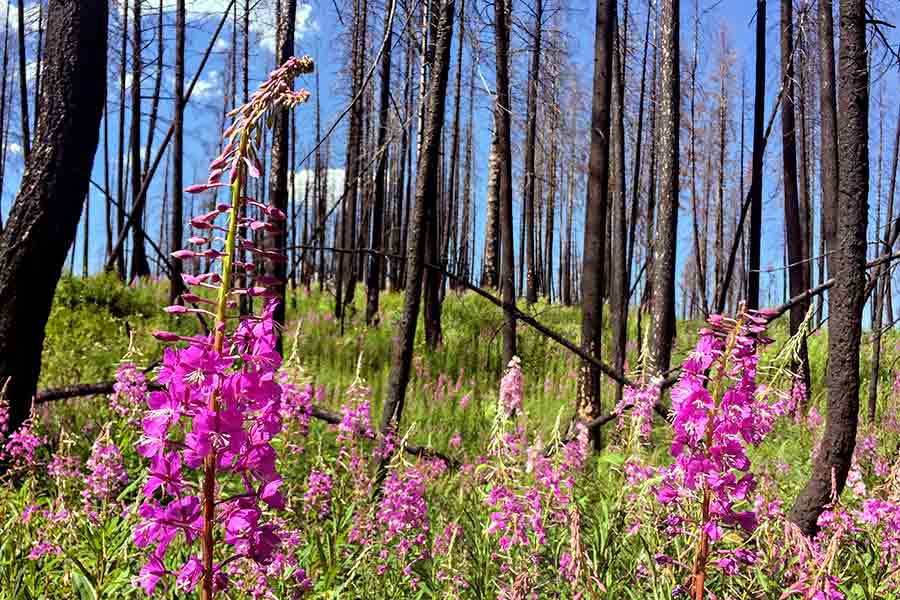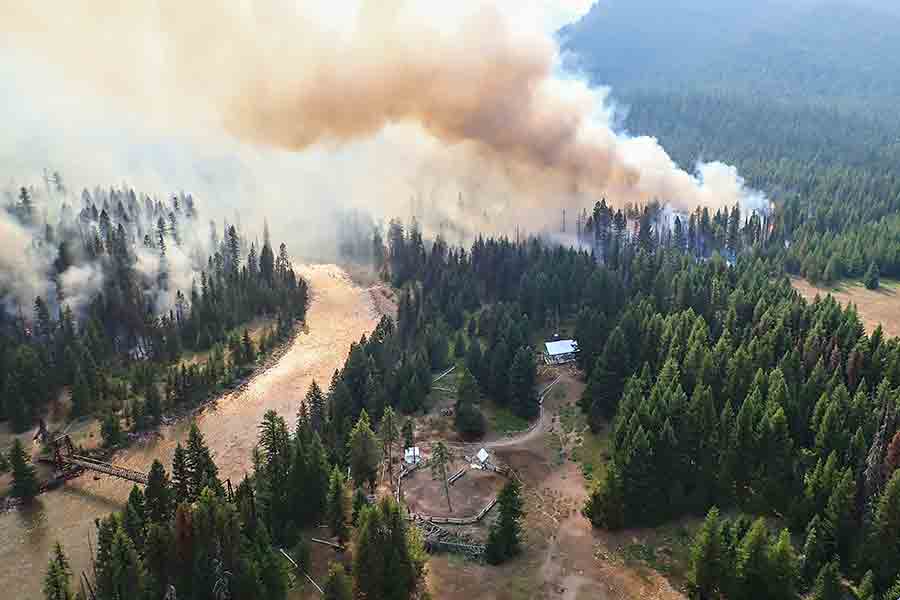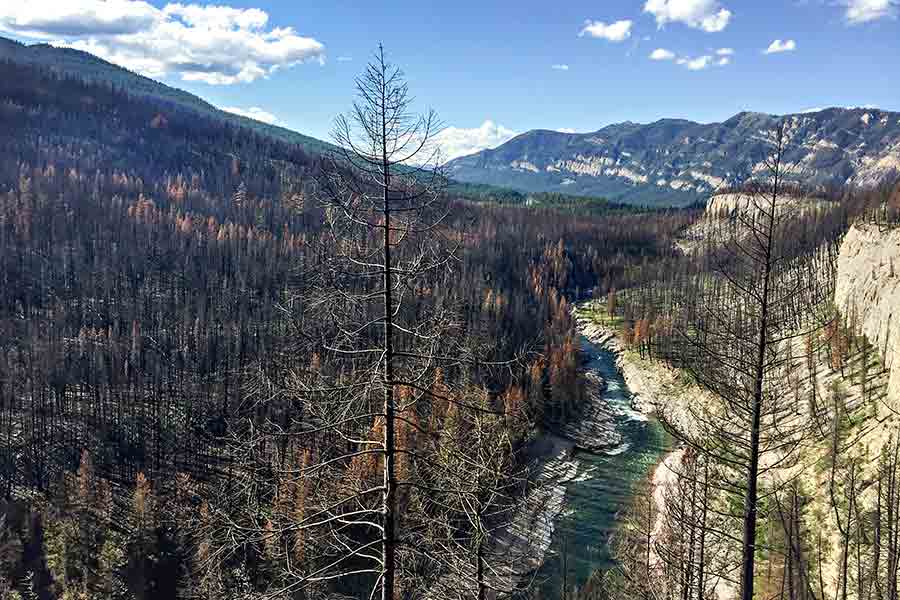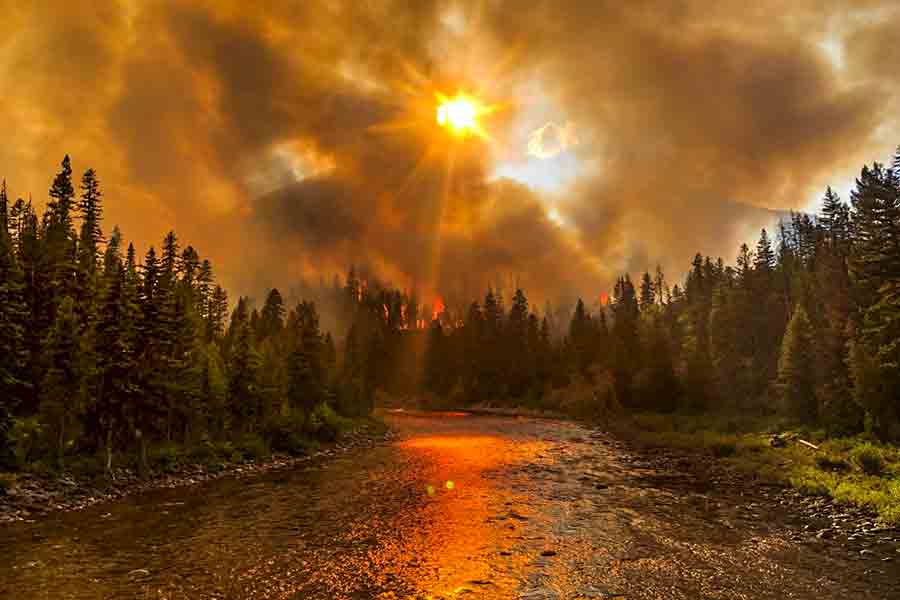Circling the Snow Creek Fire’s perimeter in a Bell 407, Jim Flint looked down at the smoke and flames creeping through a patchwork of historic burns, the scorched hillsides rising away from the South Fork Flathead River that cuts through the Bob Marshall Wilderness, where healthy stands of larch and lodgepole mingled among dead fuels.
He liked what he saw.
As the Spotted Bear Ranger District’s Fire Management Officer, Flint spends a lot of time thinking about how fire behaves in wild chunks of country. After nearly four decades of allowing lightning-caused fires to burn naturally in undeveloped wilderness areas like the one Spotted Bear oversees, managers here have cultivated a healthy fire footprint by adhering to the wilderness fire program’s ethos of allowing forests to burn for resource benefits, using suppression only when necessary, such as when structures are threatened.
Wilderness is defined by the 1964 Wilderness Act as “an area where the earth and its community of life are untrammeled by man, where man himself is a visitor who does not remain,” and the subsequent fire program implemented in 1984 recognizes fire’s natural role on the landscape.
In the ensuing years, fire has transformed the landscape by promoting forest regeneration while reducing fuel loads and creating a medley of historic impressions that interact to temper fires during the hottest, driest periods of summer. That’s apparent on a map on Flint’s desk depicting a network of polygons representing historic fires that have burned since 1984.
“We’re getting a real mosaic of fire effects,” Flint said. “We’ve got almost 40 years of allowing fire to burn naturally in wilderness. We’ve learned a lot from that. Now we can start applying what we’ve learned outside the wilderness.”
The Spotted Bear Ranger District occupies a wide swath of the Flathead National Forest and the Great Bear and Bob Marshall Wilderness areas, where lightning storms on Aug. 2 sparked the Snow Creek Fire, which continues to burn at about 1,815 acres.
On Aug. 5, the fire grew from 15 acres to nearly 500, threatening a number of historic structures, including the Black Bear Cabin and nearby pack-horse bridge and prompting Flint and the Spotted Bear crew to deploy additional resources.

By the time he flew over the fire on Aug. 8, about 25 firefighters were completing burnout operations and had wrapped the structures in a protective material, breathing a collective sigh of relief.
“It’s amazing the difference that 72 hours can make,” Flint said. “We’ll be able to reopen this area to the public soon, which is the goal. But there was definitely some anxiety for a little while.”
Managing fire in a designated wilderness area is a complicated balancing act — protecting historic infrastructure, accommodating recreational stakeholders, appeasing outfitters who depend on these open spaces for their livelihood, promoting forest and river ecology, and allowing the public to experience a landscape “untrammeled by man.” Fire is a natural occupant of wild landscapes, and the crew out of Spotted Bear walks a tight line through nuanced terrain.
For decades, the default response of the U.S. Forest Service to wildfire was to stamp it out, but science has changed the way agencies think about and manage fire. Fire suppression still plays a prominent role in management, particularly if it threatens people and communities, but understanding has shifted toward a higher degree of acceptance that fire’s natural function on the landscape leads to healthier ecosystems and reduced fuel loading.

“That’s what keeps this quality habitat diverse and intact,” Flint said. “These are 80-, 100-, 120-year-old trees that are burning, but look at the regrowth and regeneration. During extreme fire years we will do some suppression, but we only have so many resources. And there’s so much fuel because we’ve been putting out fires for so long that we can’t catch them. They burn very intensely. So we use a very light touch with some of these bigger fires.”
In fire‐adapted ecosystems like the Bob Marshall Wilderness Complex, fire plays a keystone ecological function that cannot be replicated by mechanical fuel-reduction treatments; for example, fire controls the opening of serotinous cones and seed dispersal, cycles carbon and nutrients through vegetation and organic layers, and creates habitat for wildlife species.
However, concerns about smoke impacts to communities, loss of protected habitat, and limited public support for the use of fire, among other factors, have limited fire’s restorative function outside wilderness areas and some national parks.
Flint concedes that the Spotted Bear crew could have jumped on the fire early and simply put it out, spending around $50,000 in resources that are already thin.

“Now we can spend that $50,000 somewhere else and reap the fire’s natural benefits,” Flint said. “I’m actually pretty excited about this twice-burned area that’s not taking new fire. That’s a good sign. Fire’s not bad. It just is.”
The Snow Creek fire is buffeted by the scars of fires that were left unchecked, including a 1994 fire in the Helen Creek area on the east side of the South Fork. The fire hasn’t established in the area burned by both the 2000 Helen Creek fire and the 2013 Damnation fire, but it was burning the heavy dead and downed fuels in the 2000 burn area and along the grassy slope west of the 2013 fire.
That it didn’t spread into the twice-burned area despite hot, dry conditions and significant growth elsewhere offers a telling glimpse inside the history of fire management on the Spotted Bear.
“They’ve done a really nice job creating these mosaics at Spotted Bear,” Keith VanBroeke, the Flathead National Forest’s Assistant Forest Fire Management Officer, said. “They understand that fire is part of the ecosystem, and we’re really beginning to see the benefits out here.”
Spotted Bear District Ranger Scott Snelson says it’s a testament to his predecessors who since the early 1980s have allowed fire to play its natural role with minimal interference in the forests of the Bob Marshall Wilderness.
“Wilderness is designated so that we would let natural processes be the dominant force on the landscape,” Snelson said. “We finally realized that fire has some real benefits to it, but nearly a century of suppression did not help.”
On the Spotted Bear Ranger District, the sprawling jigsaw puzzle of old fires allows new fires to following its edges, reducing fuel loads and preventing other fires from spreading.
Still, other shifting variables are at play in the Bob Marshall Wilderness, including a climate that is hotter and drier than it was historically, and recent years have invited extreme wildfires into the district, including 2015 and 2017.
“It’s not uncommon to hear the refrain, ‘I’ve never seen it like this before,’ and that’s coming from guys whose careers go back 35 and 40 years,” Snelson said. “The climate is changing. It’s hotter, drier and fire seasons are longer than ever recorded.”

That reality further complicates the role of fire managers, particularly those whose job it is to also accommodate recreational interests. After the Snow Creek Fire grew substantially, Spotted Bear crews rerouted numerous hikers and scores of float parties, coordinating with ground crews and outfitters to notify hikers and using river rangers to make contact with rafters.
“We try to accommodate them as best we can,” Snelson said. “We keep our closed areas as tight as possible and open them up as soon as we can. We try to be sensitive.”
On Aug. 14, the district reopened the main trail through the fire area, and travel is once again permitted.
“Safety has to be our priority, but it’s important for people to have access to wilderness and all of its natural elements, including wildfire,” Flint said.
Rich Lasko was the Fire Management Officer at Spotted Bear when the district had its first fire under the newly minted wilderness fire management program in 1984, as well as the next year, when the first significant fire was allowed to burn for resource benefits. That was the 1985 Charlotte Peak Fire, which burned 5,500 acres and established a benchmark for future fire operations in the Bob and other wilderness areas.
“Thinking back to the Charlotte Peak Fire, there was a heightened interest at the national level because they hadn’t yet had an aggressive fire in wilderness,” Lasko, now retired, said. “But since then there has been quite a bit of fire in the Bob Marshall managed for wilderness, and from a fire perspective it has transformed the landscape in a very positive way.”
The program was placed on hold in 1988 with the Canyon Creek Fire, which became the largest single-day fire growth on record when it blew up into a 160,000-acre blaze that ran across the Continental Divide and nearly to the town of Augusta. The Forest Service revised and re-established the program after adding a “maximum allowable perimeter” policy.
Flint calculated that between 1934 and the early 1980s, only 3,000 acres burned on the 1.5 million acres that now make up the Bob Marshall Wilderness Complex. Since 1981, more than 300,000 acres have burned at least once, while more than 60,000 acres have burned twice and around 5,000 acres have burned three times.
Lasko, who has been in touch with Flint on the Snow Creek Fire’s progress, said it seems to be yet more proof of the fire program’s efficacy.
“It’s been a very positive program out there for meeting what was envisioned in the Wilderness Act, which is to be stewards of a landscape that is untrammeled by man,” Lasko said.
